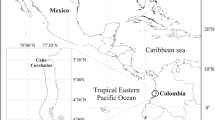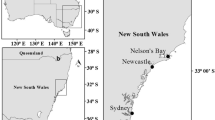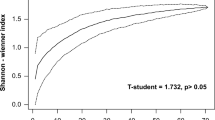Abstract
Four species of stingarees (Urolophus lobatus, U. paucimaculatus, Trygonoptera personata and T. mucosa) were abundant in samples collected from over sandy substrates in four regions along ∼200 km of the lower west coast of Australia in each season between summer 1990/1991 and winter 1992. The main aim of this study was to determine whether these four species were segregated by habitat, size, sex and/or diet, thereby reducing the potential for intra- and interspecific competition. The densities of U. lobatus and T. personata were almost invariably greater in deep, offshore waters (20 to 35 m) than in shallow, inshore waters (5 to 15 m), while those of U. paucimaculatus were greatest in the southernmost region, irrespective of depth, and those of T. mucosa were highest at the single inshore site at which the water was deep. None of these species was segregated by either size or sex. The volumetric dietary compositions of the two Urolophus species, which consisted predominantly of various crustaceans, and those of the two species of Trygonoptera, which consisted mainly of different polychaetes, were significantly different from each other. The two Urolophus species initially fed largely on amphipods, mysids and carid decapods but, with increasing size, U. lobatus started to ingest teleosts and U. paucimaculatus commenced feeding on errant polychaetes and penaeid decapods. The contribution of errant polychaetes to the diets of T. personata rose progressively from 0% in the smallest fish to 90% in the largest fish, thereby accounting for a concomitant progressive decline in dietary breadth and for intraspecific dietary overlap typically to occur only between successive size classes. In contrast, the volumetric contribution of sedentary polychaetes to the diets of T. mucosa remained high (65 to 80%) throughout life, which accounts for the relatively low and constant dietary breadth of most size classes and a significant overlap in the diets of all but one pair of size classes. The diets of each of the four stingaree species occasionally differed between sites and sometimes underwent seasonal changes, presumably reflecting spatial and temporal differences in the types of prey in the environment. Since the ratios of benthic to epibenthic prey in the diets of the two Trygonoptera species were greater than in those of the two Urolophus species, the first two species apparently forage deeper into the substrate. The combination of partial segregation of the four stingaree species among habitats and the differences in the dietary compositions and feeding strategies of these species, would presumably facilitate the co-existence of these batoid elasmobranchs when they are abundant in the same general region.
Similar content being viewed by others
Author information
Authors and Affiliations
Additional information
Received: 29 October 1997 / Accepted: 25 March 1998
Rights and permissions
About this article
Cite this article
Platell, M., Potter, I. & Clarke, K. Resource partitioning by four species of elasmobranchs (Batoidea: Urolophidae) in coastal waters of temperate Australia. Marine Biology 131, 719–734 (1998). https://doi.org/10.1007/s002270050363
Issue Date:
DOI: https://doi.org/10.1007/s002270050363




